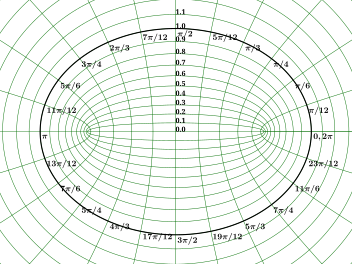Basic definition
The most common definition of elliptic coordinates  is
is

where  is a nonnegative real number and
is a nonnegative real number and 
On the complex plane, an equivalent relationship is

These definitions correspond to ellipses and hyperbolae. The trigonometric identity

shows that curves of constant  form ellipses, whereas the hyperbolic trigonometric identity
form ellipses, whereas the hyperbolic trigonometric identity

shows that curves of constant  form hyperbolae.
form hyperbolae.
Scale factors
In an orthogonal coordinate system the lengths of the basis vectors are known as scale factors. The scale factors for the elliptic coordinates  are equal to
are equal to

Using the double argument identities for hyperbolic functions and trigonometric functions, the scale factors can be equivalently expressed as

Consequently, an infinitesimal element of area equals

and the Laplacian reads

Other differential operators such as  and
and  can be expressed in the coordinates
can be expressed in the coordinates  by substituting the scale factors into the general formulae found in orthogonal coordinates.
by substituting the scale factors into the general formulae found in orthogonal coordinates.
Alternative definition
An alternative and geometrically intuitive set of elliptic coordinates  are sometimes used, where
are sometimes used, where  and
and  . Hence, the curves of constant
. Hence, the curves of constant  are ellipses, whereas the curves of constant
are ellipses, whereas the curves of constant  are hyperbolae. The coordinate
are hyperbolae. The coordinate  must belong to the interval [-1, 1], whereas the
must belong to the interval [-1, 1], whereas the  coordinate must be greater than or equal to one.
coordinate must be greater than or equal to one.
The coordinates  have a simple relation to the distances to the foci
have a simple relation to the distances to the foci  and
and  . For any point in the plane, the sum
. For any point in the plane, the sum  of its distances to the foci equals
of its distances to the foci equals  , whereas their difference
, whereas their difference  equals
equals  . Thus, the distance to
. Thus, the distance to  is
is  , whereas the distance to
, whereas the distance to  is
is  . (Recall that
. (Recall that  and
and  are located at
are located at  and
and  , respectively.)
, respectively.)
A drawback of these coordinates is that the points with Cartesian coordinates (x,y) and (x,-y) have the same coordinates  , so the conversion to Cartesian coordinates is not a function, but a multifunction.
, so the conversion to Cartesian coordinates is not a function, but a multifunction.


Alternative scale factors
The scale factors for the alternative elliptic coordinates  are
are


Hence, the infinitesimal area element becomes

and the Laplacian equals

Other differential operators such as  and
and  can be expressed in the coordinates
can be expressed in the coordinates  by substituting the scale factors into the general formulae found in orthogonal coordinates.
by substituting the scale factors into the general formulae found in orthogonal coordinates.
Applications
The classic applications of elliptic coordinates are in solving partial differential equations, e.g., Laplace's equation or the Helmholtz equation, for which elliptic coordinates are a natural description of a system thus allowing a separation of variables in the partial differential equations. Some traditional examples are solving systems such as electrons orbiting a molecule or planetary orbits that have an elliptical shape.
The geometric properties of elliptic coordinates can also be useful. A typical example might involve an integration over all pairs of vectors  and
and  that sum to a fixed vector
that sum to a fixed vector  , where the integrand was a function of the vector lengths
, where the integrand was a function of the vector lengths  and
and  . (In such a case, one would position
. (In such a case, one would position  between the two foci and aligned with the
between the two foci and aligned with the  -axis, i.e.,
-axis, i.e.,  .) For concreteness,
.) For concreteness,  ,
,  and
and  could represent the momenta of a particle and its decomposition products, respectively, and the integrand might involve the kinetic energies of the products (which are proportional to the squared lengths of the momenta).
could represent the momenta of a particle and its decomposition products, respectively, and the integrand might involve the kinetic energies of the products (which are proportional to the squared lengths of the momenta).
See also
References
This article uses material from the Wikipedia English article Elliptic coordinate system, which is released under the Creative Commons Attribution-ShareAlike 3.0 license ("CC BY-SA 3.0"); additional terms may apply (view authors). Content is available under CC BY-SA 4.0 unless otherwise noted. Images, videos and audio are available under their respective licenses.
®Wikipedia is a registered trademark of the Wiki Foundation, Inc. Wiki English (DUHOCTRUNGQUOC.VN) is an independent company and has no affiliation with Wiki Foundation.





































-direction.
-axis, i.e., the axis connecting the foci, whereas the oblate spheroidal coordinates are produced by rotating the elliptic coordinates about the
-axis, i.e., the axis separating the foci.


























